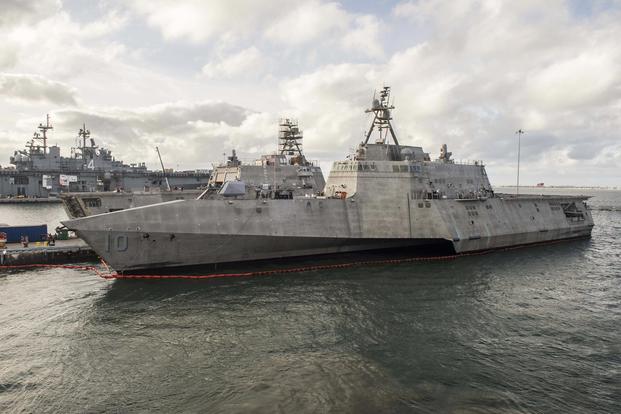Without delving into specifics, Vice Commander of Naval Operations Adm. Bill Moran said Tuesday that the Navy is "rightfully optimistic that littoral combat ships will deploy this year "100 percent fit and 100 percent full."
Vice Adm. Richard Brown, commander of Naval Surface Forces, said last week that the service plans to deploy three LCSs this year -- two from the West Coast and one from the East Coast. The deployments would mark a return to the sea for the ships for the first time in nearly two years.
The LCS Coronado (LCS 4), now considered a prototype vessel, along with LCSes 1, 2 and 3 -- returned to its home port of San Diego in December 2017, after deploying to the Pacific for 18 months. The numbers indicate the order in which the ships were built. Odd-numbered ships belong to the single-hulled Freedom-class variant built by Lockheed Martin and Fincantieri Marinette Marine; while even-numbered ships numbered 6 and higher belong to the trimaran Independence-class variant, built by a team led by Austal USA.
The Navy intended to send three ships overseas in fiscal 2018, following a complete overhaul of the LCS program that included manning adjustments, homeports and training. But those deployments never happened, largely over staffing and advanced training concerns.
Speaking to reporters Tuesday at the Surface Navy Association's annual symposium, Moran said he is "not at all worried about LCS manning right now."
"What Admiral Brown is rightly focused on is that the training for the crews is as good as we can make it," Moran said. "Talk to the junior officers. They'll tell you the training they've gotten before getting on those ships is far better than they've received on any other ships."
According to Brown, the Montgomery, LCS-8, and the Gabrielle Giffords, LCS-10, should deploy from San Diego, and the Detroit, LCS-7, will deploy from Florida. Little Rock, LCS-9, is slated to deploy in early fiscal 2020, also from Florida.
"Operational commanders just can't wait to get these ships," Brown said at the symposium.
U.S. Naval Institute News reported earlier this year that LCS crews suffered from manning shortfalls, with no excess members to fill manning gaps, and the Navy poaching crew members from crews serving on pre-commissioned vessels to support commissioned ships.
Citing briefing slides from Naval Surface Force Pacific, USNI reported that enlisted sailors arriving at LCS vessels were not fully trained, with 31 percent arriving with only a primary enlisted classification.
However, on Tuesday, Brown said that the vessels are "incredibly capable ships" and crews will be ready to deploy.
"The class starts with LCS 5 and those ships just came out of post-shakedown availability last year. ... From the materiel standpoint, I think they are doing just fine," he said.
The LCS is designed to perform offshore -- what Brown described as a "single-mission vessel" conducting anti-surface warfare operations, such as partner-building exercises and maritime patrols. The vessels will receive missile modules that will increase their lethality and capability to provide security in environments where small boats pose a threat, Navy leaders said.
The Navy commissioned the Freedom-class Wichita, LCS 13, last Saturday at Naval Station Mayport, Florida.
Moran said the vessels will be equipped so that they are more than "just a presence" in the regions they patrol.
"LCS 5 to 12 are reliable ships," Moran said.
-- Patricia Kime can be reached at patricia.kime@gmail.com. Follow her on Twitter @patriciakime.









